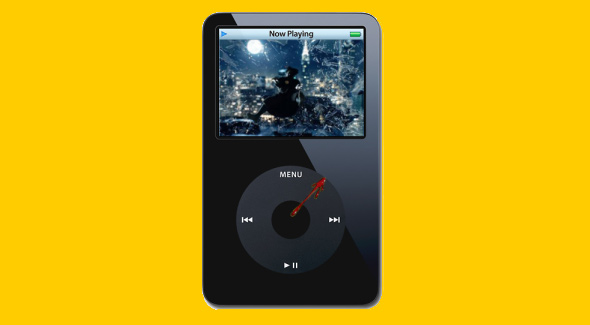
Tasha Robinson, over at the Onion’s AV Club, has an excellent piece up comparing the book and film versions of Watchmen. In addition to the obligatory laundry list of fannish greivances, she points out a crucial difference between the two versions that Snyder had no control over: comics are a medium of visual narrative, while film is a medium of audiovisual narrative. Robinson is talking about the actors’ performances, and she does a good job explaining the effects of that. But she doesn’t mention the other big part of the film’s soundscape: music. And that’s kind of a shame, because the music department did something really interesting here. (Our own Mlawski saw this coming, as devout OTIketeers will no doubt recall…)
Spoilers ahead, for what it’s worth. Though I doubt anyone would read this without having seen the movie anyway.
About half of Watchmen takes place in the present (well, the ’80s) and serves to advance the plot. Another half takes place in flashbacks of one sort or another, and serves to advance character development. Sections from these two halves alternate throughout the movie: first the Comedian gets killed, second we get his backstory told through various flashbacks at his funeral, then we get some more plot, then someone else’s story (Dr. Manhattan’s, I think?), and so on. In the comic, a full issue was devoted to the backstory of each main character. The film omits the backstory segments for Night Owl and Silk Spectre — the “real people” as commenter Josh points out — leaving us with backstory segments for the Comedian, Dr. Manhattan, Rorschach, and Ozymandias. Each of these takes place in completely different musical worlds.
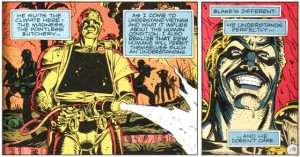
Maake 'em laaaaaaugh, make 'em laaaaaaugh! Don't you know everyone wants to laaaaaugh?
The Comedian’s segment is scored almost entirely with pop songs. Part of this is just practical, since telling the Comedian’s story requires the filmmakers to establish a large number of very specific moments in American culture. But there may be more to it than that. Pop songs are one of the ways in which we represent our own culture to ourselves: the 70s as viewed through punk and funk is not a particularly accurate picture of the 70s, but it’s somehow more vivid than the truth. To put it another way, whatever else I’m Proud to be an American is, it’s also a thesis — or better, a story — about what being an American means, and in a less obvious way so are The Thong Song and Master of Puppets, and so on down the line. Movies tend to highlight this aspect of pop songs, using them to invest the characters’ actions with meaning. Sometimes the characters themselves will get in on the act. This is always a powerful moment. In the hands of a director like Cameron Crowe, who obviously believes in the transcendent power of music, it can be touching (c.f. John Cusack holding up the jukebox in Say Anything). In the hands of a director like Francis Ford Coppola who doesn’t believe, it is shockingly nihilistic. I think you all know the scene I mean, and while this might not technically be pop music, it’s iconic enough that it might as well be.
http://www.youtube.com/watch?v=sx7XNb3Q9Ek
In cases like this, the characters are either cynical or deluded, consciously using music to narrativize their random actions with a significance that they in no way deserve. And this idea — that history and culture are just stories we tell to feel better about the essential brutality of existence — is what the character of Eddie Blake is all about. So perhaps it should come as no surprise that the Comedian’s story contains an obvious homage to the Coppola sequence, Wagner and all, with Dr. Manhattan in the role of the helicopters. And for a moment, as we have heard the Comedian’s story through the past of rock, we see it through the past of film.
It also occurs to me that our association of pop music with the Comedian might be meant to effect our experience of pop music when it pops up in the “present-day” sections of the film (which musically are sort of all over the place, although generally effective). Take the midair sex scene, choreographed orgasmically (not in a good way) to Leonard Cohen’s Hallelujah. I wonder if the icky editing combines with the film’s general cynicism about pop music to create something intentionally off-putting and grotesque, as opposed to merely a tone-deaf miscalculation, which is how most critics are reading it. Certainly the song can be read as an attempt (of the transparent, failed class) to “narrativize” a pointless biological act. Hallelujah is ABSOLUTELY the song that Dan Dreiberg would have thrown on the ‘ol hi-fi to try to get Laurie in a romantic mood. But intentional or not, the scene was pretty hard to watch.
Rorschach’s flashback, appropriately enough, gets the soundtrack of a horror film. It’s all drawn out metallic groans, heartbeat-like thumps, and dissonant orchestral “stabs” highlighting his assorted violent acts. This particular kind of horror scoring can probably be traced to the original 1974 Texas Chainsaw Massacre, where it arose organically out of the roar of the chainsaw itself. Since then, it’s been used to greater or lesser effect in any number of films, to the point where most horror scores nowadays just alternate between this kind of texture and a couple of disposable heavy metal tracks for the chase scenes. (And this from the genre that brought us Herrmann’s score to Psycho! O tempora, o mores, oh well.) Overexposed or not, it works well here, likely because it’s so different from everything else that’s going on in the soundtrack. I have less to say about this one than some of the others, maybe because it’s less interesting as music in its own right… but one thing that is interesting about this sequence, I suppose, is that if Rorschach’s history is a slasher film, he is quite clearly the slasher. The killer in these movies is always an unstable outsider who exacts disproportionate revenge on people who violate the social contract (by, you know, having sex, or being the one black guy in the cast). Rorschach even wears a mask, for crying out loud! AND he has mommy issues.
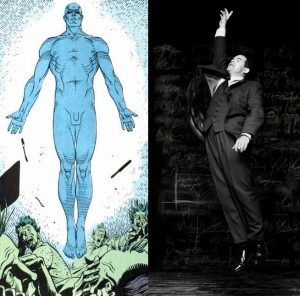
I tried to find a naked picture of Oppenheimer for symmetry, but no luck. And now my Google autocomplete thinks I'm demented.
The elaborate Dr. Manhattan sequence is in many ways the heart of the soundtrack (and perhaps of the film as well: over at the avclub, Robinson writes that she could watch this part “again and again”). Once again, the filmmakers go with pre-composed music, but in this case it’s all drawn from a single source: Phillip Glass’ soundtrack to Koyaanisqatsi. You’ve probably heard this music before (if only in the trailer for Grand Theft Auto IV): pulsating organ arpeggios punctuated with repeated chords in the brass and choir, all with consonant harmonies don’t so much modulate as just sloooowly move from one place to another. (Lots of neo-Riemannian voice leading, for people who care about that sort of thing.)
The first thing that should be said about this music is that it works, absolutely works. After seeing it scored this way, any other music would be unthinkable. But this raises the inevitable question: why these sounds? Why no others? Why, no how can late minimalism — which is enough of a cliche that it’s been mocked on South Park — fit so perfectly here? I have a couple of answers for this, and while any of them, on their own, would be a little reductive, I hope that together they can begin to suggest something like the truth.
The image paired with Dr. Manhattan above is taken from the promotional materials for John Adams’ recent opera Dr. Atomic, which is a mythicized retelling of the Trinity test shot, the official dawn of the nuclear age. The man in the picture is Robert Oppenheimer (photographed jumping by Philippe Halsman), who is the central character of Adams’ piece, and has a lot to do with Moore’s Dr. Manhattan. Both were government scientists who, through their work on highly dangerous technology, became transfigured into something else. Of course, Oppenheimer’s transformation was not literal — like I said in the caption, I couldn’t find any pictures of his naked blue genitals — but while Oppenheimer the man remained, Oppenheimer the idea has become something of an occult figure. He’s by no means the only person who built the bomb, but it’s his name and his personality that we associate with it, and like Dr. Manhattan, an aura of spirituality surrounds him. (Famously, he reacted to the test shot by quoting from the Baghavad-Gita: “Now I am become death, destroyer of worlds.”) Why is any of this relevant? Well, Adams is also a minimalist composer, and while his particular style does not in point of fact particularly resemble Koyaanisqatsi, there’s still a certain resonance. Were the music editors consciously referencing Adams’ opera? Unlikely, but possible. Is there something about nuclear annihilation that implies minimalism? Surprising if true. But certainly, no one who was aware of the opera could have watched the Dr. Manhattan segment without being reminded of it, and thus of Oppenheimer. And that is no bad thing.
Now, there are really only two interesting things about Dr. Manhattan. The first, already discussed, is his role as the spectre of radioactive death. The second is his perception of time. Where we experience the present, and can remember the past, he experiences past present and future all at once. (Or perhaps only remembers all of them, and never experiences anything? It’s unclear.) This is the second reason why the score of this sequence is so effective. Minimalism, I will argue, encourages us to experience time as Dr. Manhattan does.
Consider a piece of music. Any music will do, as long as you’re familiar with it, but for now I’ll assume you’re considering the Beatles’ All My Loving. This song, like nearly all other songs, exists in linear time. You BEGIN with “Close your eyes, and I’ll kiss you” and THEN move on to “tomoooorow I’ll miss you,” which leads naturally TO “Remember I’ll always be true,” and so on. Each phrase — of text, of notes — has its own musical identity, and each implies the next in a rigidly causal relationship. The same holds true of Beethoven’s fifth symphony. It starts with “Dah-dah-dah-duuuuuum,” and then moves on to that other “Dah-dah-dah-duuuuum,” and proceeds in linear fashion to the final cadence. And this should work with whatever song you picked, provided you didn’t pick something minimalist, which would completely defeat the purpose of this little demonstration.
With minimalism, the rules are different. The phrases don’t lead to eachother, they just happen one after another. And they don’t each have their own identity: massive blocks of music (whole minutes and tens of minutes) will share an essential identity. Changes, when they occur, are either incremental and barely noticeable, or massive and systemic. That is, a block of music can slowly change within itself, or it can be juxtaposed with another block of music. These two techniques are the heart and soul of minimalist composition. (Mind you, that’s a bit like saying that forming sentences and joining them into paragraphs is the heart and soul of writing.) Minimalist music and tonal music (what some might just call “normal music”) both develop, but while tonal music’s development is that of an organism, minimalism’s is that of a clock. In a piece of tonal music, you could play any section of the song in isolation, and know exactly where to go next (provided you know the song). Minimalism doesn’t work like that. There’s too much repetition: here the “Da-da-da-duuum’s” are all too similar, and not just on the surface, they’re conceptually similar too. As a result, understanding where you are in a piece of minimalist music requires paying attention to the things that are different from eachother, i.e. the larger blocks of repeated music. And to know how these larger blocks of music line up, you have to experience the entire piece of music in your mind at once. Or maybe just remember it all at once? It’s unclear.
Now I’ll play the devil’s advocate. While the Dr. Manhattan sequence in Watchmen is quite extended for a film score cue, it’s nowhere near long enough – or static enough – to create an altered temporal state through brute repetition alone. If my analysis works here, it’s because people are familiar enough with minimalism that even a fragmentary minimalist gesture will trigger these listening habits. Musical-minded as I am, I find this idea tremendously appealing! But isn’t it more likely that the altered sense of time this music evokes comes from our knowledge of Koyaanisqatsi the film, rather than Koyaanisqatsi the score?
Nevertheless, I’m sure that the music plays a role. Why else would Reggio have asked Glass to score Koyaanisqatsi in the first place? Also, while most people who noticed this music at all will notice that it’s minimalist, I doubt that many will have pegged it specifically as Koyaanisqatsi. I didn’t realize it myself until another film score buff pointed it out to me — I just thought the composer was doing a Glass pastiche. (In my defense, it’s pretty easy music to do a pastiche of.)
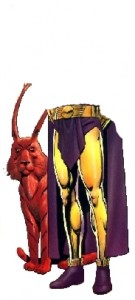
Look on my works, ye mighty, and despair!
Finally, there’s Ozymandias. There’s not a lot to say here, for a very good reason: there’s no music. Or rather, no underscoring. Instead we have source music (music coming from the world of the film, music that the characters can hear), and even this is just the elevator music that’s piped into the foyer of Veidt’s office, which is kind of an anti-music. (Incidentally, the only way you really know that this music is source music is the way it’s mixed into the master audio track. It’s not like the camera pans across the speakers, or anything. So kudos to youdos, supervising sound editor Scott Hecker!) Arguably this was a bad choice on the part of the filmmakers, since it makes Veidt soulless as all get-out, telegraphing — and perhaps trivializing? — his villainy. It’s also worth noting that Veidt’s is the only backstory that is told entirely without the use of flashback: we just see him standing there narrating. So whether this soundtrack decision is boneheaded or not, it’s definitely fully integrated into the broader fabric of the film, and that in itself is enough to get me excited. And hey, since you don’t have enough time to establish organically how much of a capitalist pig he is, why not hammer it home by making Muzak his theme song?
One final note: the Watchmen soundtrack includes Nina Simone’s hair-raising rendition of Pirate Jenny, a song which Moore has acknowledged as an inspiration for the Black Freighter material, and one which I didn’t notice in the film. This suggests that the extended edition will be just as thoughtful in its use of music as the theatrical release. And you know what? The soundtrack itself is pretty freaking killer. For the most part, filming Watchmen was simply a game of not ruining the source material, but the sound track was one place where Snyder’s team had the opportunity to do something good, original, and artistic. They did not let us down.
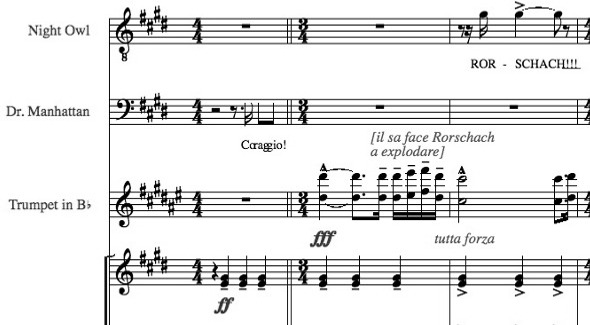
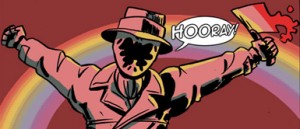
Ozymandias’s elevator music was telling in itself: Tears for Fears’ “Everybody Wants to Rule the World.” It was one of the more subtle ways that Snyder reduced Veidt from a conflicted antihero into a cartoonish, power-mad emo villain.
Unfortunately for me, most of the music had the effect of reminding me I was watching a movie. The references were too obvious and really, too cute by half. Any time you roll “Flight of the Valkyries” you had better be going for comedy because people are going to laugh. I don’t think Dr. Manhattan winning the war in Vietnam was supposed to be hilarious. Like everything else in Watchmen it was supposed to be tragic and sad.
And Re: Nite Owl’s choice of baby-making music. There was a song reference in the book for that scene and I’m pretty sure it was and Ella Fitzgerald tune. It was not Halle-freaking-lujah.
Very insightful, Stokes. I have a lot of thoughts on this subject; here’s my first Re: Valkyries:
I’ve been going back and forth on this. Part of me thinks it was a cheap way to score audience points. It’s a cliche use of classical music in film along the lines of “Also Spach Zarusthra.”
On the other hand, your justification of the music as a way to highlight the nihilism of the on-screen activity makes sense.
But as far as I can remember, Watchmen didn’t have another similarly strong and recognizable reference to another movie like this, through music or other means. If that was the case, I think you could agree that it was a bit out of place.
For some reason, the use of KC and the Sunshine Band’s “I’m Your Boogie Man” during the Comedian/riot sequence really clicked for me. It sort of perverts the pop culture of the time the way you’ve suggested, and it’s even a sort of sly play on words (The Comedian sort of becomes the US government’s secret boogeyman).
Also, as far as I’m concerned, the use of Hendrix’s “All Along the Watchtower” was about as awkward as “Hallelujah”. Sure, the book references the like “Two riders were approaching”, but how many movies about the 60s have used this song? It’s one of those songs that sort of becomes ingrained in the movies that use it (much like Wagner and Apocalypse Now). I guarantee you 70-80 percent of the audience thought of Forrest Gump when that scene showed up.
The use of “Flight of the Valkries” might seem cliche, but think back to the first chapter of Under the Hood and how much “Flight of the Valkries” means to Hollis. I’ll wait.
The use of “The Times They Are A-Changin'” over a packed-but-never-overwhelming opening credit sequence was pretty bold, considering that most superhero movies would eschew a nominally acoustic ballad for something more “inspiring.” It keyed you off right away (if you weren’t convinced by the opening sequence of the Comedian going through his window) that this ain’t your average superhero movie.
I’ve always been a big believer in the importance of music in film, if only because it can be used to either emphasize or undercut the visuals onscreen. Of course, some movies get by with next to nothing in the way of a “soundtrack” as in “music accompanying the action onscreen,” but the movies that stick with me tend to have a lot of good music or at least music that is good within the context of the film (I’m thinking about all the times that a catchy pop song might be used ironically, like “What a Wonderful World” over scenes of slightly sanitized Vietnam War carnage in “Good Morning Vietnam”). To me, “Watchmen” had a pretty good balance of songs to the film that both commented on the action and also enhanced it as to make it more memorable.
Zack Snyder has talked about the use of Hallelujah in an interview with Crave Online. The akwardness and all is definitely intentional he explains: “There are two Leonard Cohen’s because there is a Leonard Cohen on the end titles as well. Hallelujah, that love scene, I originally had the Allison Crowe version of that song, a version I’ve always loved, but in the end was just too romantic. Everybody thought that I meant it. They thought the love scene was serious, not that it isn’t serious but her version was too sexy. So I was like yeah, I’ve got to go back to the Leonard Cohen. For me it is incredibly ironic, even with that version of the song it is incredibly ironic. I don’t care what version of Hallelujah is on, that love scene it is ridiculous, but in a great way. With Leonard Cohen it is like you can’t miss it now, can you? I’m sure some people will but that is fine.”
@Wade: I’m totally with you on “Boogie Man.” Loved that scene.
@Roz: It’s no surprise that Snyder intended the sex scene to be ironic, but does anyone really think that the same scene in the comic book was meant to be ironic as well? For a movie that stayed so devoted to the tone and feel of the source, I found this to be a jarring and disruptive departure.
@PassAmongImpure I remember that part from “Under the Hood” now.
So I concede that the filmmakers were referencing that, but think about the audience that hasn’t read the graphic novel. They’re scratching their heads wondering why the movie is referencing “Apocalypse Now.”
I get that Snyder was trying to be ironic, but it was SO heavy-handed. Ironic music cues work great in something like The Simpsons, or say, an amusing marching band halftime show. Here it just seemed like the director was trying to hard. Like, “Huh, huh? You get it?”
Also, if Snyder really was trying to be ironic and send up not only superhero comics but superhero/action movies, then why were his action sequences so un-ironic? It wasn’t like he was making fun of bullet time. He was like, “Bullet time! Cool!” And all of the ultraviolence didn’t get into irony territory for me because most of it was far too cartoonish.
But! I did like All Along the Watchtower because A) the comic reference and B) that song is amazing. It can be in every movie for all I care. Same goes for Philip Glass music.
Oh, PS, I just noticed the image on the carousel for this piece. Niiiiice. Thank you, Mr. Stokes.
@Wade: Agreed about the use of KC and the Sunshine Band.
Unfortunately, the only other lyrical song I felt positively engaged with apart from that was “The Times They Are a Changing.” I found the songs distracting every other time, either because they seemed to fail at an attempt to be tongue-in-cheek/ironic (Tears for Fears) or just didn’t seem to make sense (“99 Red Balloons”). Music of a non-lyrical nature was always spot-on for me, though, so what I was hearing during Rorschach and Dr. Manhattan’s backstories totally enhanced the experience for me.
Oh, except the Wagner- sorry, but mkd already said it: you’re NOT not going to get people laughing if you use that piece in anything today, and I refuse to believe Snyder didn’t know this when he picked the piece. And that laughter more often than not has nothing to do with “Apocalypse Now,” by the way. Of the people I know in person that have seen _Watchmen_ and laughed at that song being in it, only one has seen “Apocalypse Now,” and that is myself.
Oh, and Lee, I don’t think the sex scene in its entirety was meant to be funny in the graphic novel. The little burst-o-flame was, yes, but up until that point, I think it was meant to be a more serious portrayal of Dan’s inability to function without his masked identity. The dialogue in that scene is shifted around for the film version- it’s LAURIE that cracks the joke about WWIII, not Dan, in the book. And the rest of the dialogue suggests she is, as with the previous time they had tried to have sex, the one making the initial advance. I guess I just never read the scene as funny beyond the, “Oh, look at how awkward and cute Dan is,” at the start and the shot of fire, and the movie turning it into a joke kind of pissed me off, especially since Dan and Laurie had already been watered down so much.
Of course, I can also play Devil’s Advocate and say the scene in the movie wasn’t supposed to be funny (as in funny ha-hah), either, but in fact show how Dan BECOMES the sexual aggressor (not like the Comedian, though) because of that same change in dialogue and how even when she’s the one on top, it looks more like he’s doing her than she’s doing him the whole time. I still find this argument harder to swallow because of how unsettling the scene was; and one of the big “unsettling” factors for me was, to bring it back home, “Halleluja.”
He could have used Rufus Wainwright’s version…
My favorite bit of the soundtrack was the Kyrie Eleison from Mozart’s Requiem, played as I recall when NO and SS are walking out of the ruins of Karnak. A very classy and subtle choice, I thought (but I do just like that piece a lot).
Kyrie Eleison – “Lord have Mercy”
Indeed.
Just to brag- I immediately knew it was Koyaanisqatsi. That music is so evocative for me- i instantly saw that piece of exploded rocket spinning down in slow-motion.
Which is something you missed here, i think- i like the analysis of minimalism you do. But much more simply- the arrival of Doc Manhattan into the world is, in the world of Watchmen, the moment that modern times irrevocably becomes “Koyaanisqatsi:” Life out of Balance
“Unfortunately for me, most of the music had the effect of reminding me I was watching a movie. The references were too obvious and really, too cute by half.”
I liked this. I believe it was because of the parallel universe – deliberately calling up your cultural associations with our past to better connect with theirs. Other examples: Andy Warhol in the title sequence, the Dr Strangelove war room, even 99 Luftballons instantly recall a particular era of history. One of the chief points of the film is that the characters are very human, very ordinary – these real world ties help remind us.
Thought: How often do regular superhero movies use such easily recognisable music? Ideally, to prove my point, the answer should be very rarely. I can’t think of any other examples…